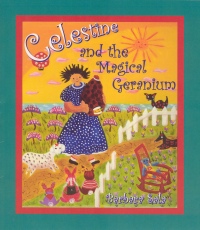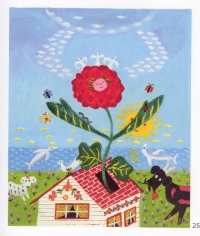| ________________
CM . . .
. Volume XI Number 12 . . . .February 18, 2005
excerpt:
This picture book is a parable in which a young girl, Celestine, receives the gift of a seed in a bag of potatoes on her famine ravaged island. The seed becomes a mysterious geranium which grows because of love and kindness. The plant can talk to Celestine and becomes a castle with many rooms. Everyone is entranced by the geranium, and hordes come to visit, and they eventually kill the plant. The geranium gives Celestine a final gift with all the seeds she has left behind and so everyone has their own "loving geranium."
One of the themes of this story is the cycle of life and the expression of love through giving. There are other books on this theme, like The Giving Tree by Shel Silverstein (HarperCollins, 1969), which express more poignancy and appeal through a more eloquent use of language. Not Recommended Lorraine Douglas was the Coordinator of Youth Services for the Winnipeg Public Library and is now retired and living in Winnipeg, MB.
To comment
on this title or this review, send mail to cm@umanitoba.ca.
Copyright © the Manitoba Library Association. Reproduction for personal
use is permitted only if this copyright notice is maintained. Any
other reproduction is prohibited without permission.
NEXT REVIEW |
TABLE OF CONTENTS FOR THIS ISSUE
- February 18, 2005.
AUTHORS |
TITLES |
MEDIA REVIEWS |
PROFILES |
BACK ISSUES |
SEARCH |
CMARCHIVE |
HOME |

 This on-demand publication is awkwardly designed. The pamphlet folded paperback is centre stapled, and the opening page contains the title, author, a decorated initial and the first sentence of the story. Most readers who are knowledgeable about book design will try to start reading on the next recto page even though the pages are numbered. The illustrations were originally done in oil and acrylic on board, and they are vividly coloured and have a naive quality and charm. Each painting is signed by the artist which is unusual in a picture book, and this addition gives the impression that the paintings were done first and a story imagined later. The illustrations are not integrated with the sans serif text which appears in coloured boxes.
This on-demand publication is awkwardly designed. The pamphlet folded paperback is centre stapled, and the opening page contains the title, author, a decorated initial and the first sentence of the story. Most readers who are knowledgeable about book design will try to start reading on the next recto page even though the pages are numbered. The illustrations were originally done in oil and acrylic on board, and they are vividly coloured and have a naive quality and charm. Each painting is signed by the artist which is unusual in a picture book, and this addition gives the impression that the paintings were done first and a story imagined later. The illustrations are not integrated with the sans serif text which appears in coloured boxes.